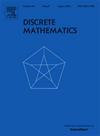图中k-团的完全隔离
IF 0.7
3区 数学
Q2 MATHEMATICS
引用次数: 0
摘要
对于图G=(V(G),E(G))和任意正整数k,若G−N[D]不包含k-团,且D诱导出无0度顶点的子图,则集D≥V(G)称为G的总k-团隔离集。总k-团隔离数ιt(G,k)是G的总k-团隔离集的最小基数。显然,ιt(G,1)是G的总统治数,最近由Boyer, Goddard和Henning研究了ιt(G,2)。证明了当k≥3且n≥k+2时,若G是n阶连通图,则ιt(G,k)≤2nk+2。边界是尖锐的。本文章由计算机程序翻译,如有差异,请以英文原文为准。
Total isolation of k-cliques in a graph
For a graph and any positive integer k, a set is called a total k-clique isolating set of G if contains no k-clique and D induces a subgraph with no vertex of degree 0. The total k-clique isolation number is the minimum cardinality of a total k-clique isolating set of G. Clearly, is the total domination number of G, and was investigated by Boyer, Goddard and Henning recently. In this paper, we prove that for and , if G is a connected graph of order n, then . The bound is sharp.
求助全文
通过发布文献求助,成功后即可免费获取论文全文。
去求助
来源期刊

Discrete Mathematics
数学-数学
CiteScore
1.50
自引率
12.50%
发文量
424
审稿时长
6 months
期刊介绍:
Discrete Mathematics provides a common forum for significant research in many areas of discrete mathematics and combinatorics. Among the fields covered by Discrete Mathematics are graph and hypergraph theory, enumeration, coding theory, block designs, the combinatorics of partially ordered sets, extremal set theory, matroid theory, algebraic combinatorics, discrete geometry, matrices, and discrete probability theory.
Items in the journal include research articles (Contributions or Notes, depending on length) and survey/expository articles (Perspectives). Efforts are made to process the submission of Notes (short articles) quickly. The Perspectives section features expository articles accessible to a broad audience that cast new light or present unifying points of view on well-known or insufficiently-known topics.
 求助内容:
求助内容: 应助结果提醒方式:
应助结果提醒方式:


